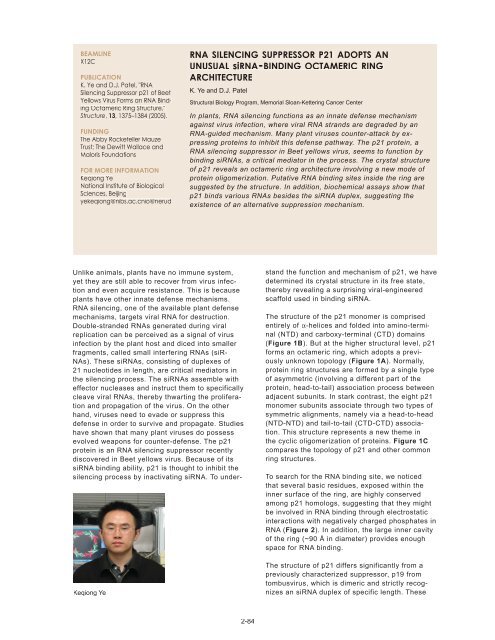NSLS Activity Report 2006 - Brookhaven National Laboratory
NSLS Activity Report 2006 - Brookhaven National Laboratory
NSLS Activity Report 2006 - Brookhaven National Laboratory
You also want an ePaper? Increase the reach of your titles
YUMPU automatically turns print PDFs into web optimized ePapers that Google loves.
BEAMLINE<br />
X12C<br />
PUBLICATION<br />
K. Ye and D.J. Patel, "RNA<br />
Silencing Suppressor p21 of Beet<br />
Yellows Virus Forms an RNA Binding<br />
Octameric Ring Structure,"<br />
Structure, 13, 1375–1384 (2005).<br />
FUNDING<br />
The Abby Rockefeller Mauze<br />
Trust; The Dewitt Wallace and<br />
Maloris Foundations<br />
FOR MORE INFORMATION<br />
Keqiong Ye<br />
<strong>National</strong> Institute of Biological<br />
Sciences, Beijing<br />
yekeqiong@nibs.ac.cnio@nerud<br />
Unlike animals, plants have no immune system,<br />
yet they are still able to recover from virus infection<br />
and even acquire resistance. This is because<br />
plants have other innate defense mechanisms.<br />
RNA silencing, one of the available plant defense<br />
mechanisms, targets viral RNA for destruction.<br />
Double-stranded RNAs generated during viral<br />
replication can be perceived as a signal of virus<br />
infection by the plant host and diced into smaller<br />
fragments, called small interfering RNAs (siR-<br />
NAs). These siRNAs, consisting of duplexes of<br />
21 nucleotides in length, are critical mediators in<br />
the silencing process. The siRNAs assemble with<br />
effector nucleases and instruct them to specifically<br />
cleave viral RNAs, thereby thwarting the proliferation<br />
and propagation of the virus. On the other<br />
hand, viruses need to evade or suppress this<br />
defense in order to survive and propagate. Studies<br />
have shown that many plant viruses do possess<br />
evolved weapons for counter-defense. The p21<br />
protein is an RNA silencing suppressor recently<br />
discovered in Beet yellows virus. Because of its<br />
siRNA binding ability, p21 is thought to inhibit the<br />
silencing process by inactivating siRNA. To under-<br />
Keqiong Ye<br />
RNA SILENCING SUPPRESSOR P21 ADOPTS AN<br />
UNUSUAL siRNA-BINDING OCTAMERIC RING<br />
ARCHITECTURE<br />
K. Ye and D.J. Patel<br />
Structural Biology Program, Memorial Sloan-Kettering Cancer Center<br />
In plants, RNA silencing functions as an innate defense mechanism<br />
against virus infection, where viral RNA strands are degraded by an<br />
RNA-guided mechanism. Many plant viruses counter-attack by expressing<br />
proteins to inhibit this defense pathway. The p21 protein, a<br />
RNA silencing suppressor in Beet yellows virus, seems to function by<br />
binding siRNAs, a critical mediator in the process. The crystal structure<br />
of p21 reveals an octameric ring architecture involving a new mode of<br />
protein oligomerization. Putative RNA binding sites inside the ring are<br />
suggested by the structure. In addition, biochemical assays show that<br />
p21 binds various RNAs besides the siRNA duplex, suggesting the<br />
existence of an alternative suppression mechanism.<br />
2-84<br />
stand the function and mechanism of p21, we have<br />
determined its crystal structure in its free state,<br />
thereby revealing a surprising viral-engineered<br />
scaffold used in binding siRNA.<br />
The structure of the p21 monomer is comprised<br />
entirely of α-helices and folded into amino-terminal<br />
(NTD) and carboxy-terminal (CTD) domains<br />
(Figure 1B). But at the higher structural level, p21<br />
forms an octameric ring, which adopts a previously<br />
unknown topology (Figure 1A). Normally,<br />
protein ring structures are formed by a single type<br />
of asymmetric (involving a different part of the<br />
protein, head-to-tail) association process between<br />
adjacent subunits. In stark contrast, the eight p21<br />
monomer subunits associate through two types of<br />
symmetric alignments, namely via a head-to-head<br />
(NTD-NTD) and tail-to-tail (CTD-CTD) association.<br />
This structure represents a new theme in<br />
the cyclic oligomerization of proteins. Figure 1C<br />
compares the topology of p21 and other common<br />
ring structures.<br />
To search for the RNA binding site, we noticed<br />
that several basic residues, exposed within the<br />
inner surface of the ring, are highly conserved<br />
among p21 homologs, suggesting that they might<br />
be involved in RNA binding through electrostatic<br />
interactions with negatively charged phosphates in<br />
RNA (Figure 2). In addition, the large inner cavity<br />
of the ring (~90 Å in diameter) provides enough<br />
space for RNA binding.<br />
The structure of p21 differs significantly from a<br />
previously characterized suppressor, p19 from<br />
tombusvirus, which is dimeric and strictly recognizes<br />
an siRNA duplex of specific length. These

















